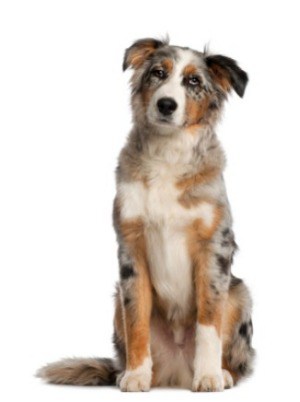An Australian Shepherd’s ear canal is warm, dark, and moist, making it an ideal site for bacterial or yeast infections, tumors, and parasites, such as ear mites. Unlike a human’s ear canal, which lies basically in a horizontal line from the side of the head inward to the eardrum, a dog’s ear canal is L shaped. The internal ear canal descends vertically before making a roughly 45-degree bend and terminating in a horizontal stretch to the eardrum. Debris loves to collect in the 45-degree bend of the ear canal.
The key to preventing ear problems is to keep ears clean, and to know the difference between a clean-smelling ear and a problem ear. A healthy ear should have a clean, healthy doggy smell – resembling the smell of beeswax, somewhat. Honey-colored wax in the ear is normal, but a crusty, dark substance may indicate problems, such as ear mites. An infected ear has an unmistakably foul odor. Ear infections are serious, and should never be ignored or taken lightly.
If your Australian Shepherd’s ears have a discharge; smell bad; the canals look abnormal, red, or inflamed; or your dog is showing signs of discomfort, such as depression or irritability, scratching or rubbing his ears or head, shaking his head or tilting it to one side – these are signs of a problem. Seek veterinary attention right away. An ear infection left untreated can cause permanent damage to a dog’s hearing.
To help prevent problems, get in the habit of examining your Aussie’s ears regularly for wax, ear mites, and other irritations. If your Aussie walks or plays in pastures, fields, or areas with heavy underbrush – check his ears frequently for stickers, burs, and other foreign matters.
How To Clean Your Australian Shepherd’s Ears
You’ll need:
- An ear-cleaning product specifically designed for dogs
- Cotton or gauze pad
Place a few drops of cleaner into the dog’s ear canal and gently massage the base of the ear for about 20 seconds. This helps to soften and loosen the debris. When you’re done, let your dog have a good head shake to eject the cleaning solution and debris from the ear canal. Next, apply some ear-cleaning solution onto a clean cotton or gauze pad. Gently wipe the inside ear leather, and the part of the ear canal that you can see.
Never stick cotton applicator swaps or pointed objects into the ear canal because this tends to pack the debris rather than remove it. More important, you risk injuring your dog’s eardrum should you probe too deeply.
If you suspect problems, seek veterinary attention right away and leave the probing to the experts.

